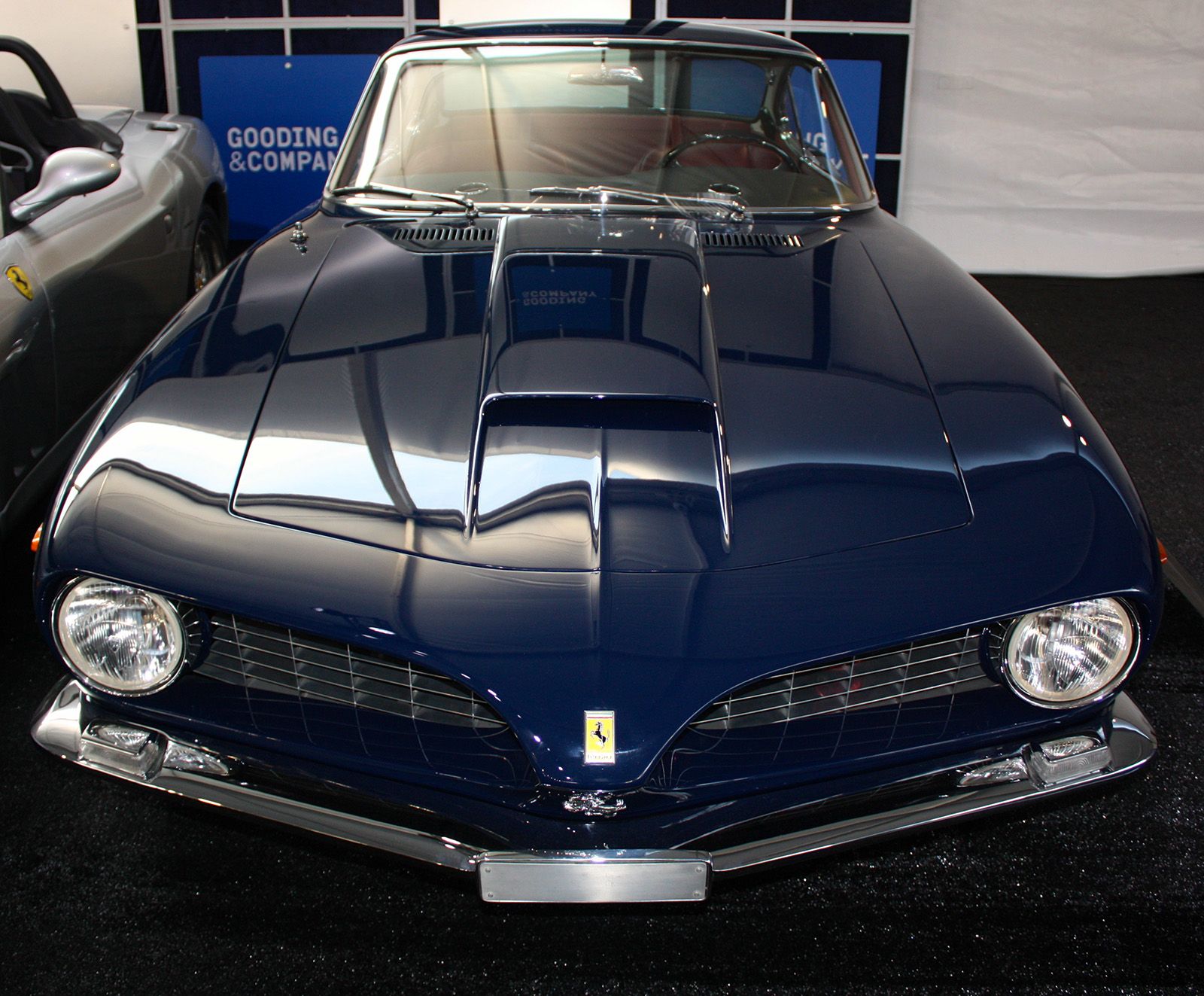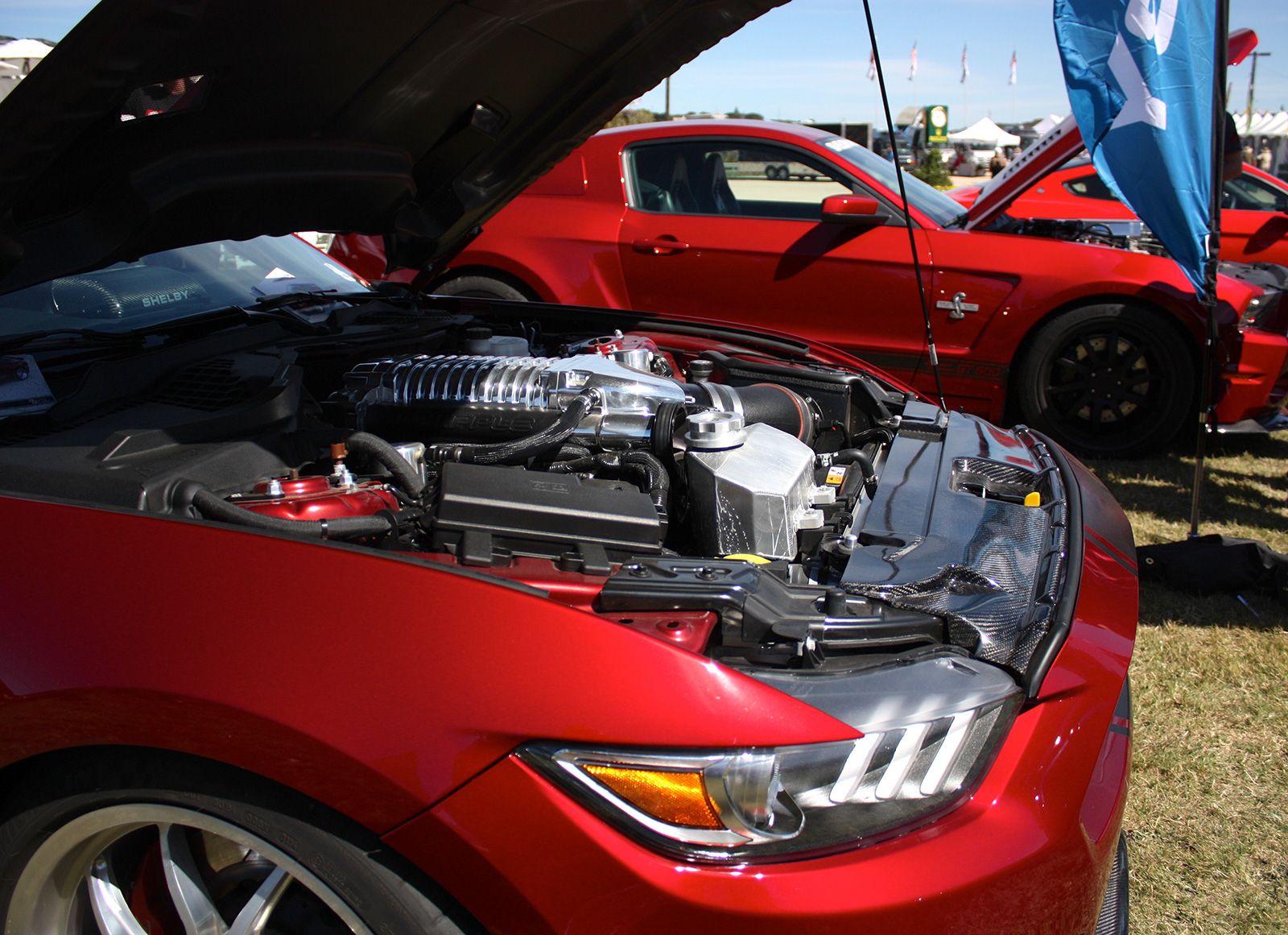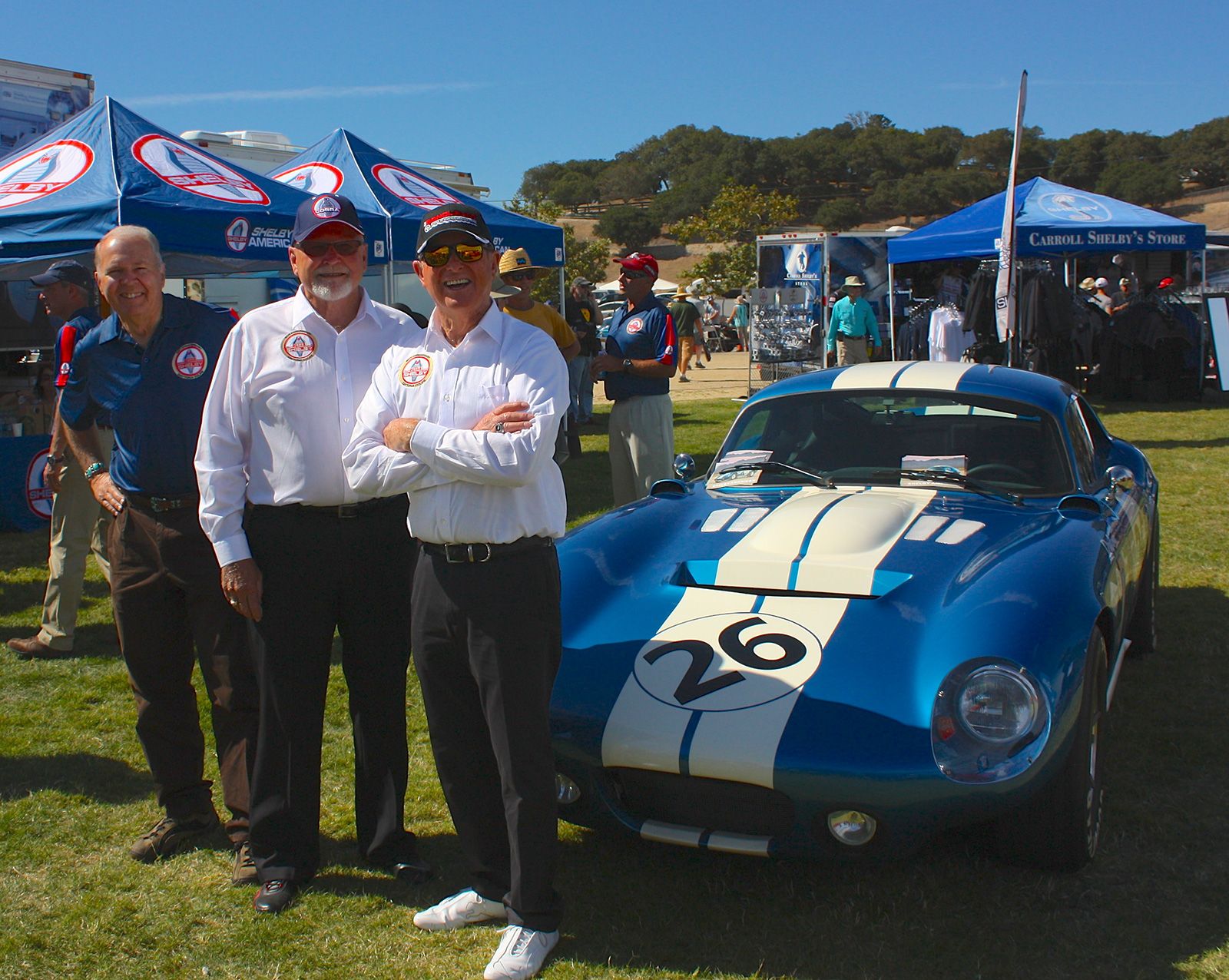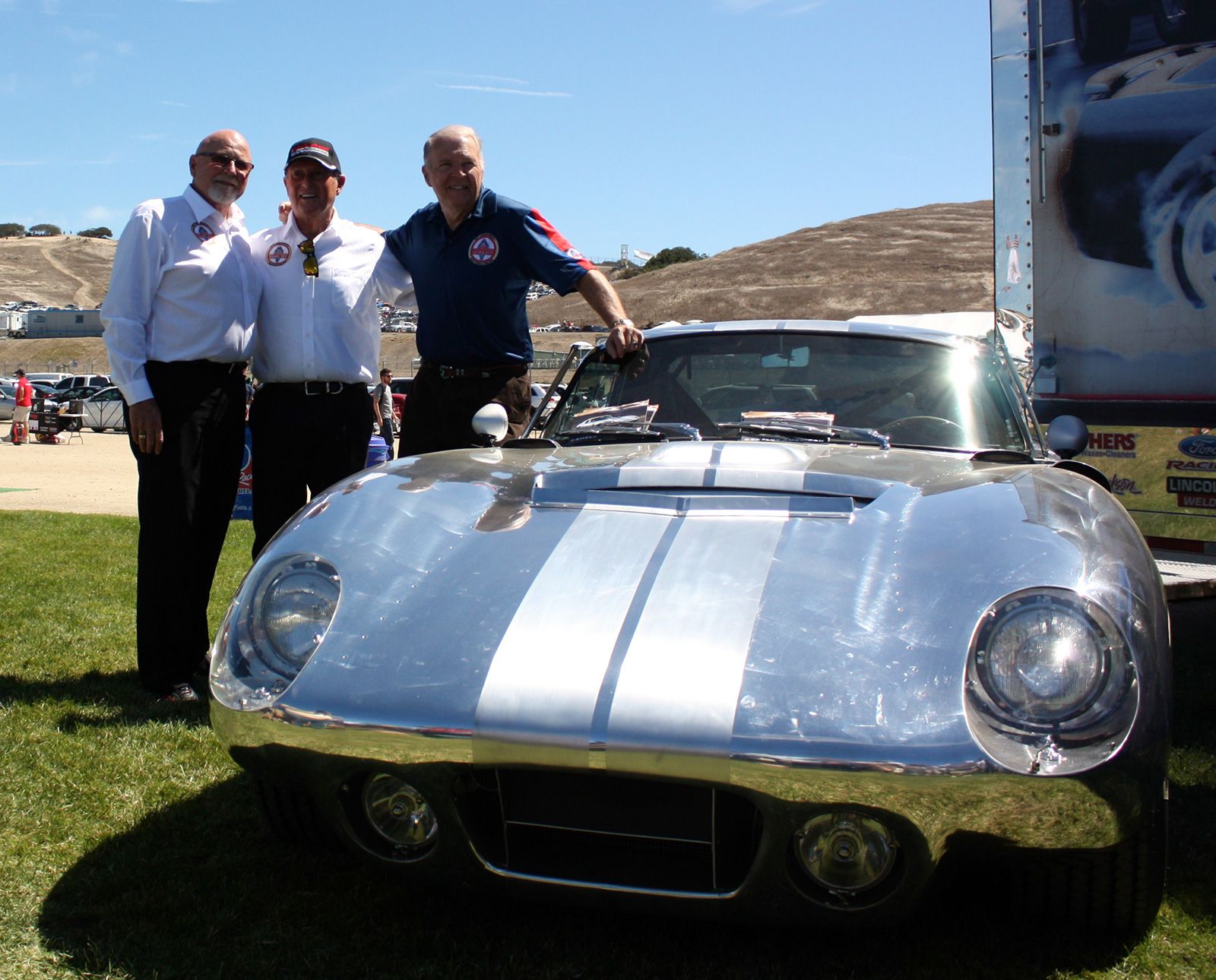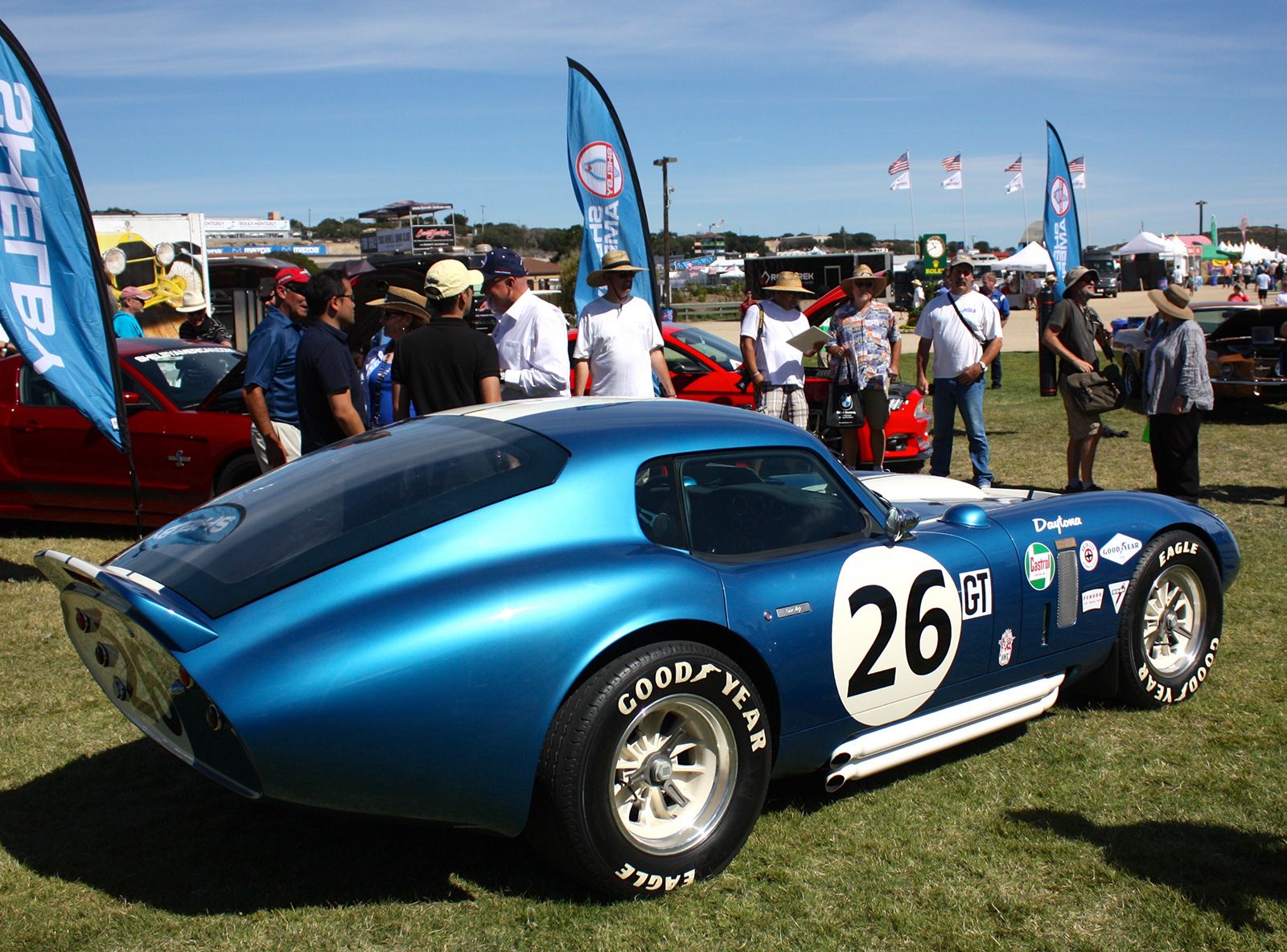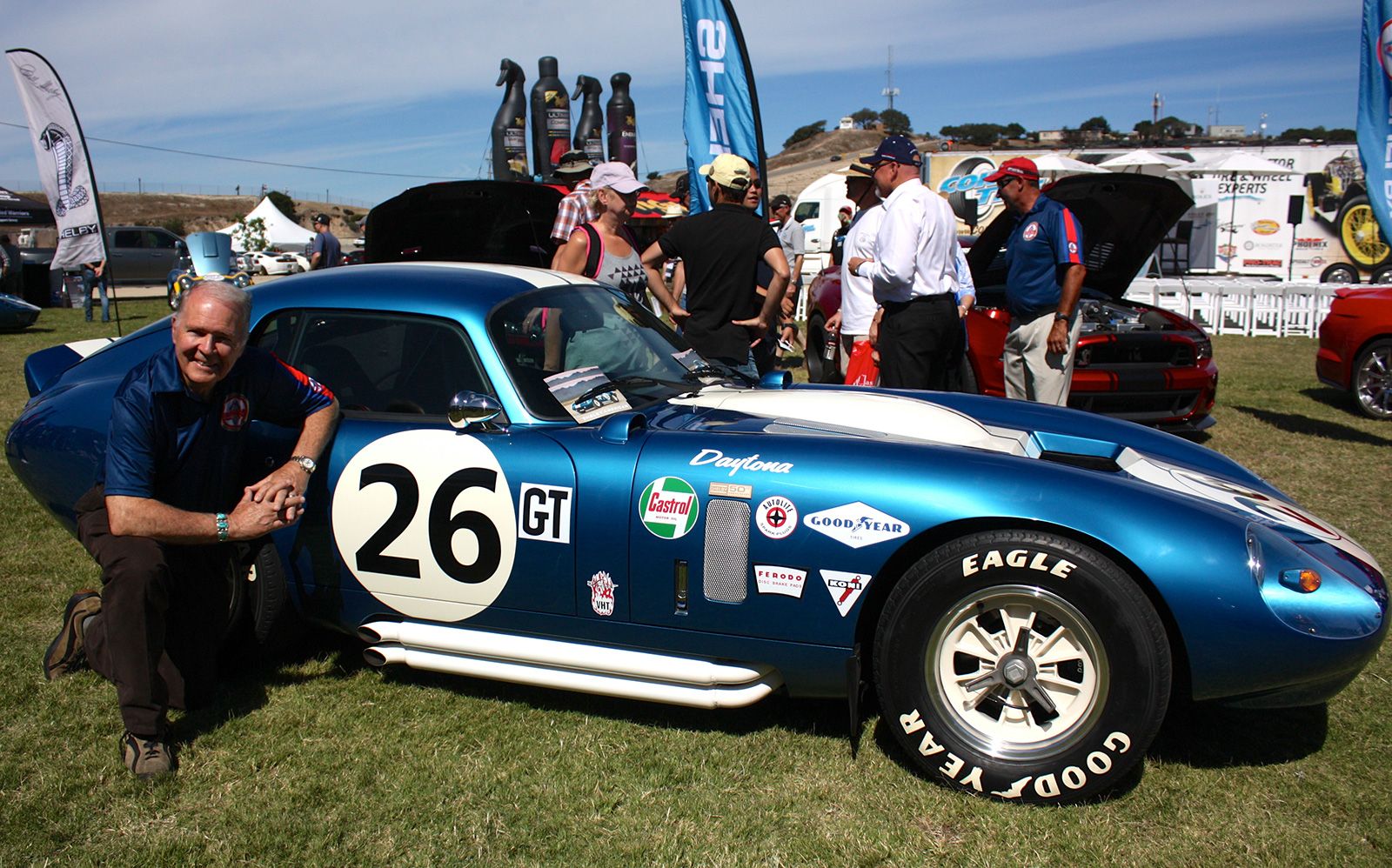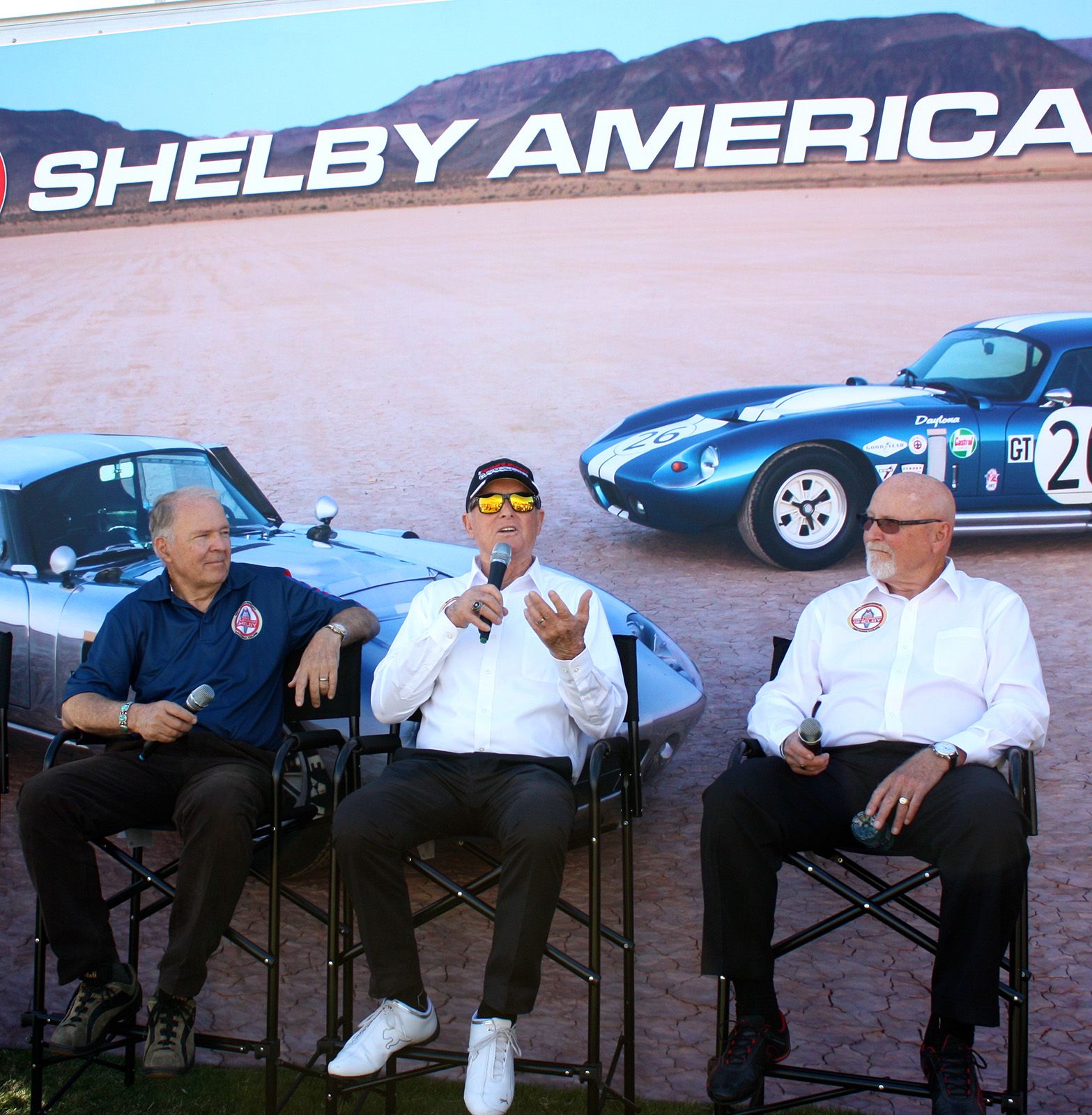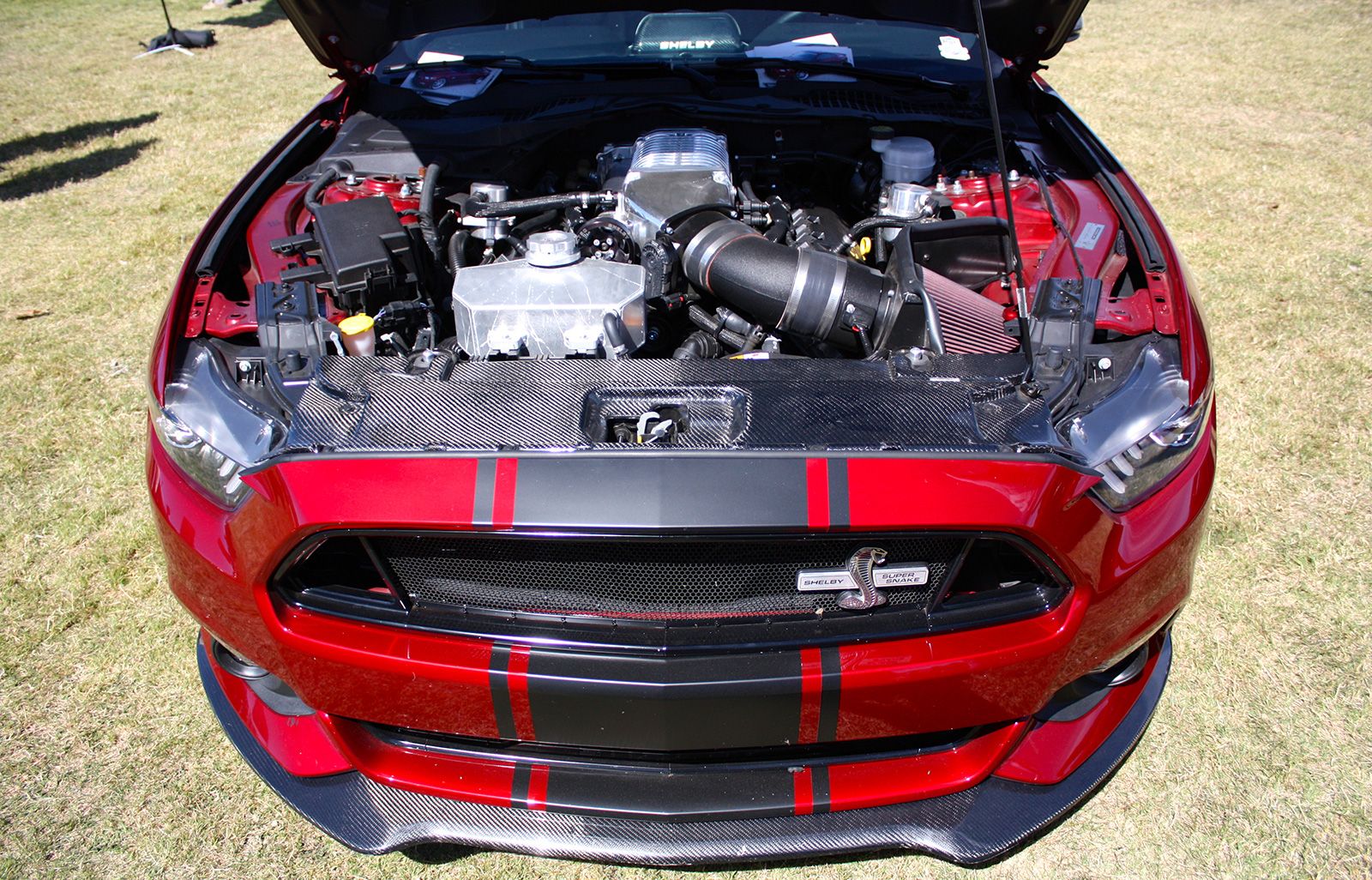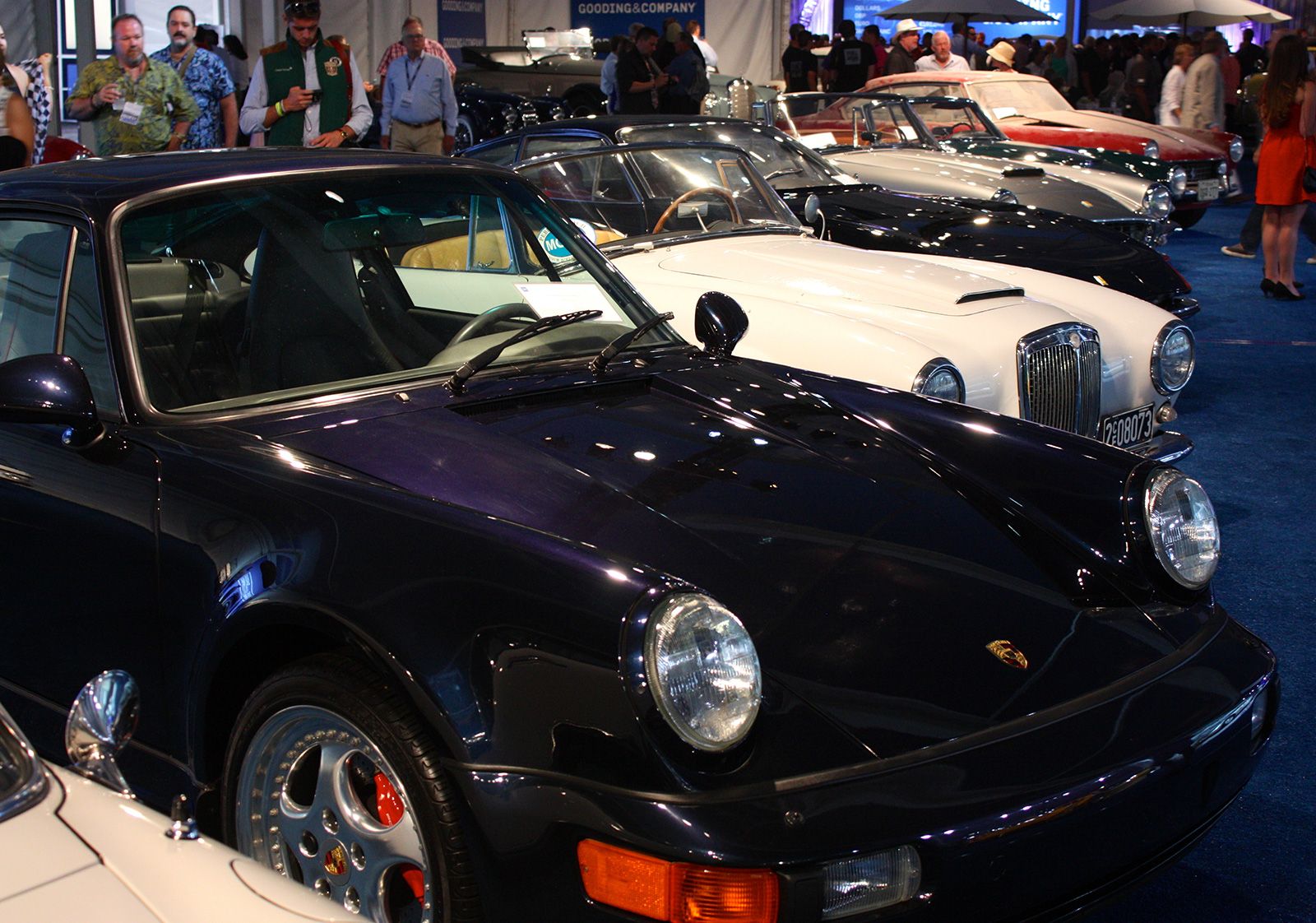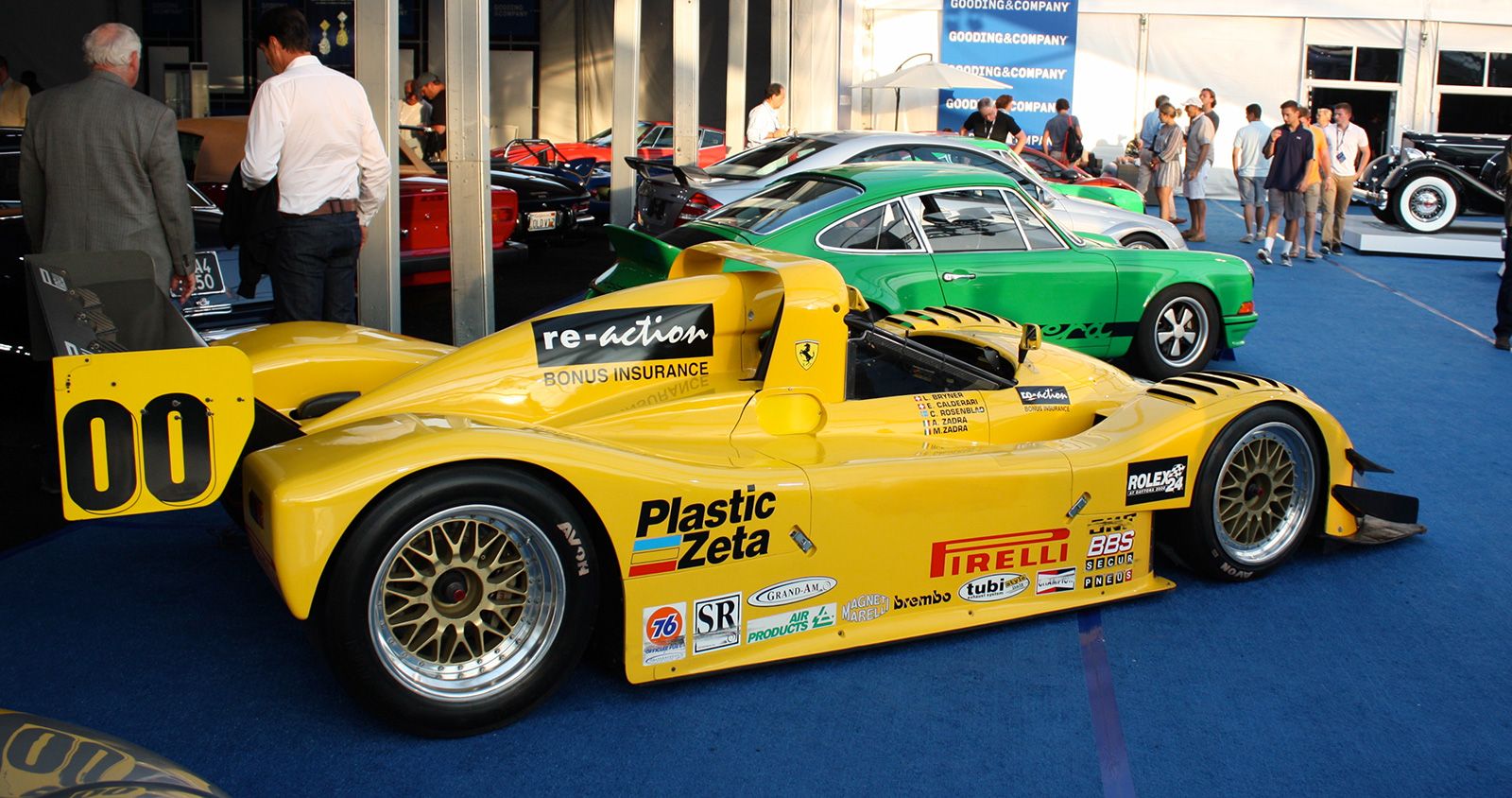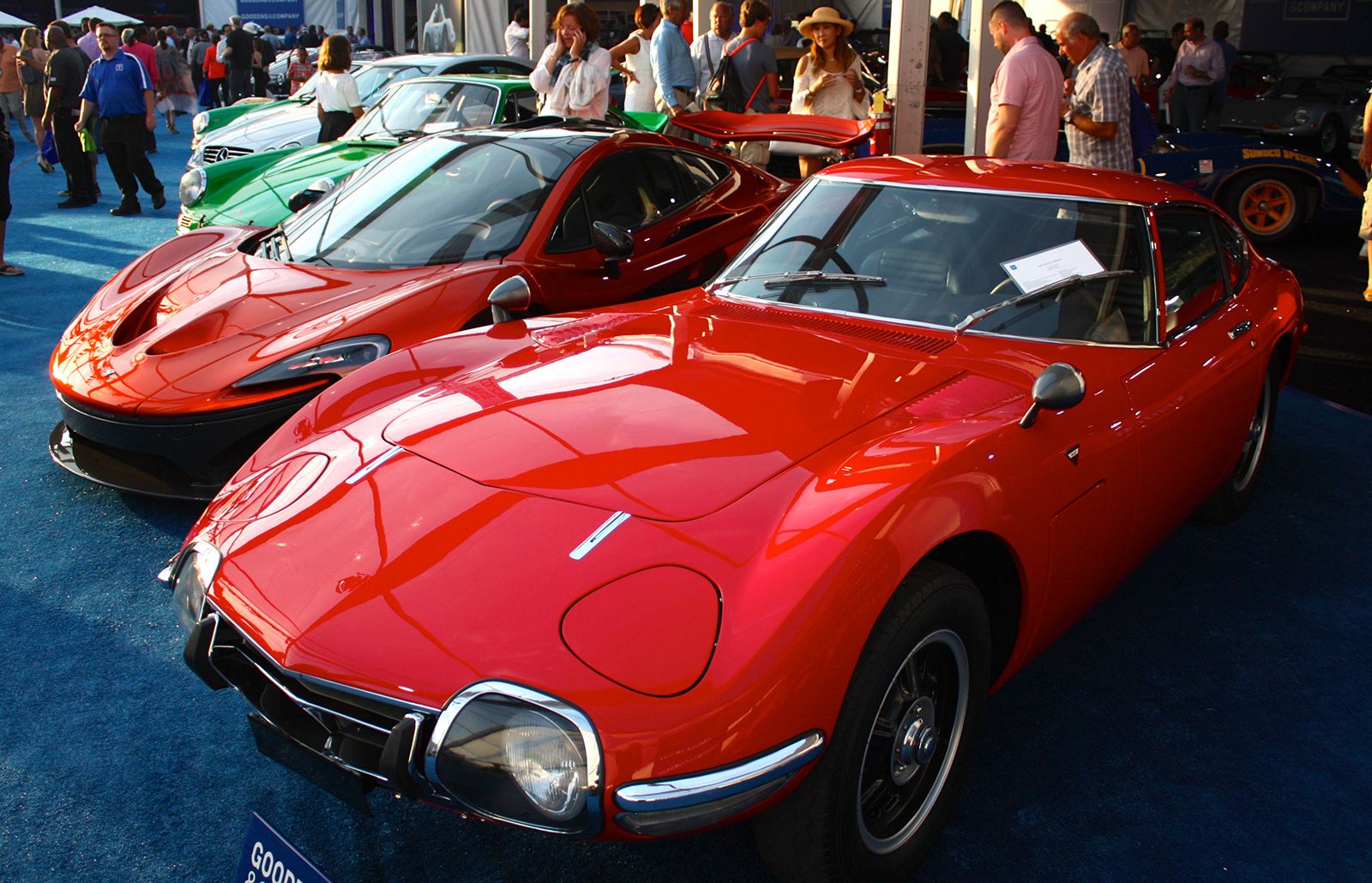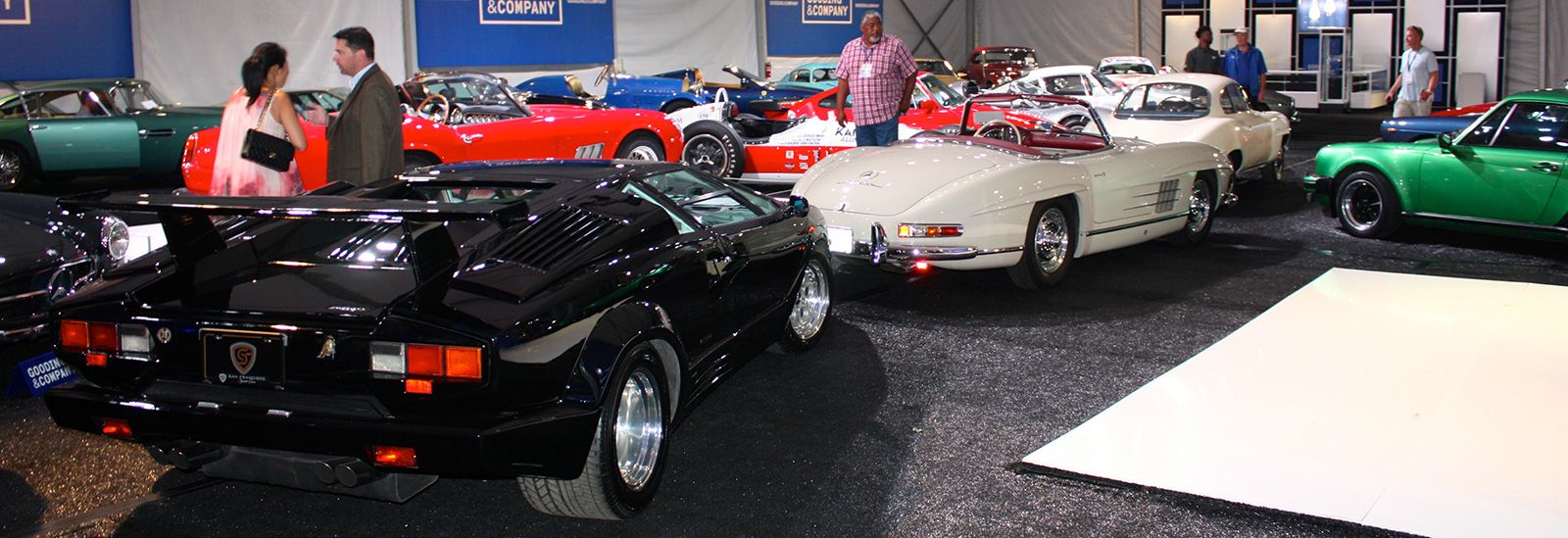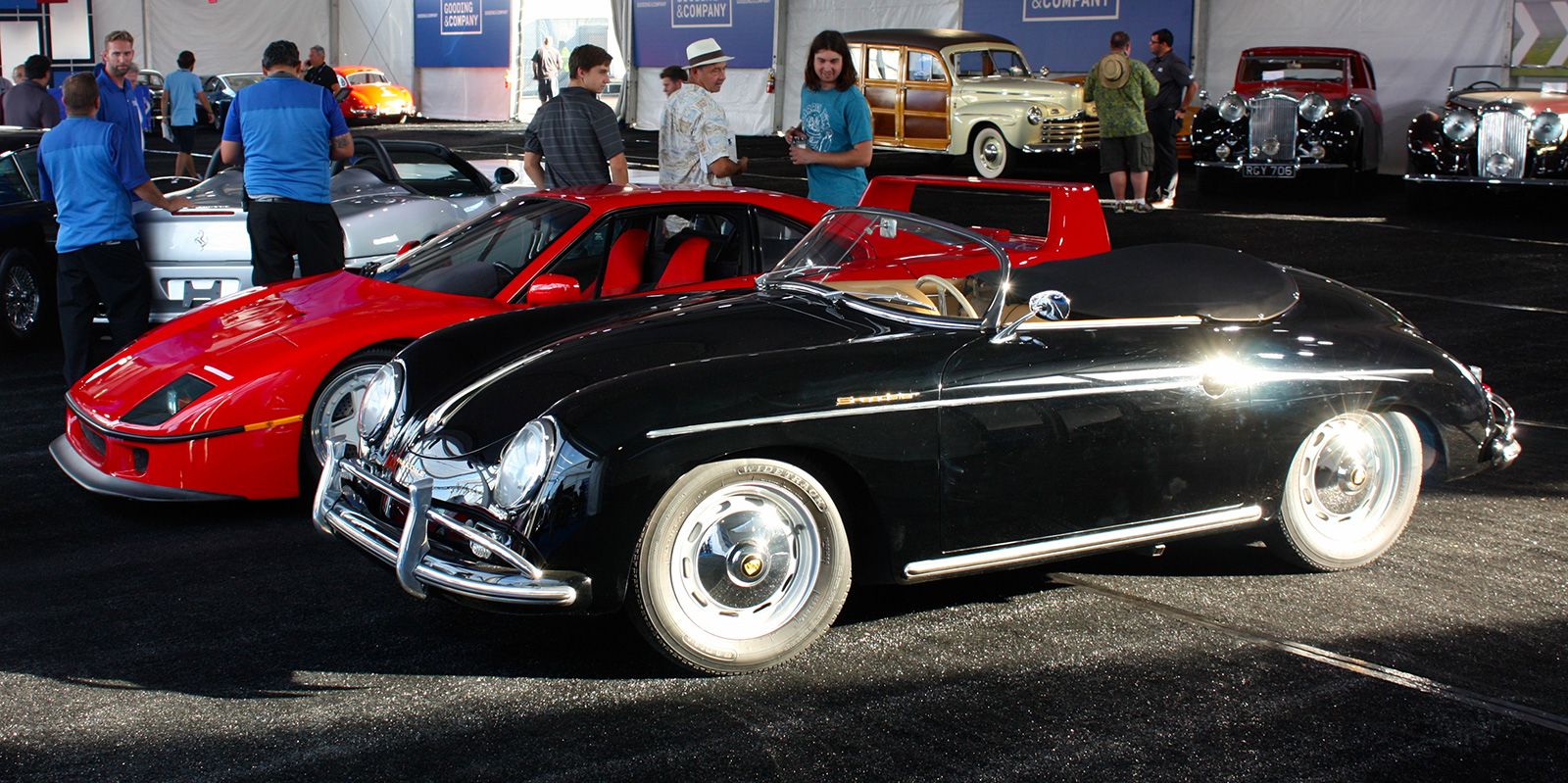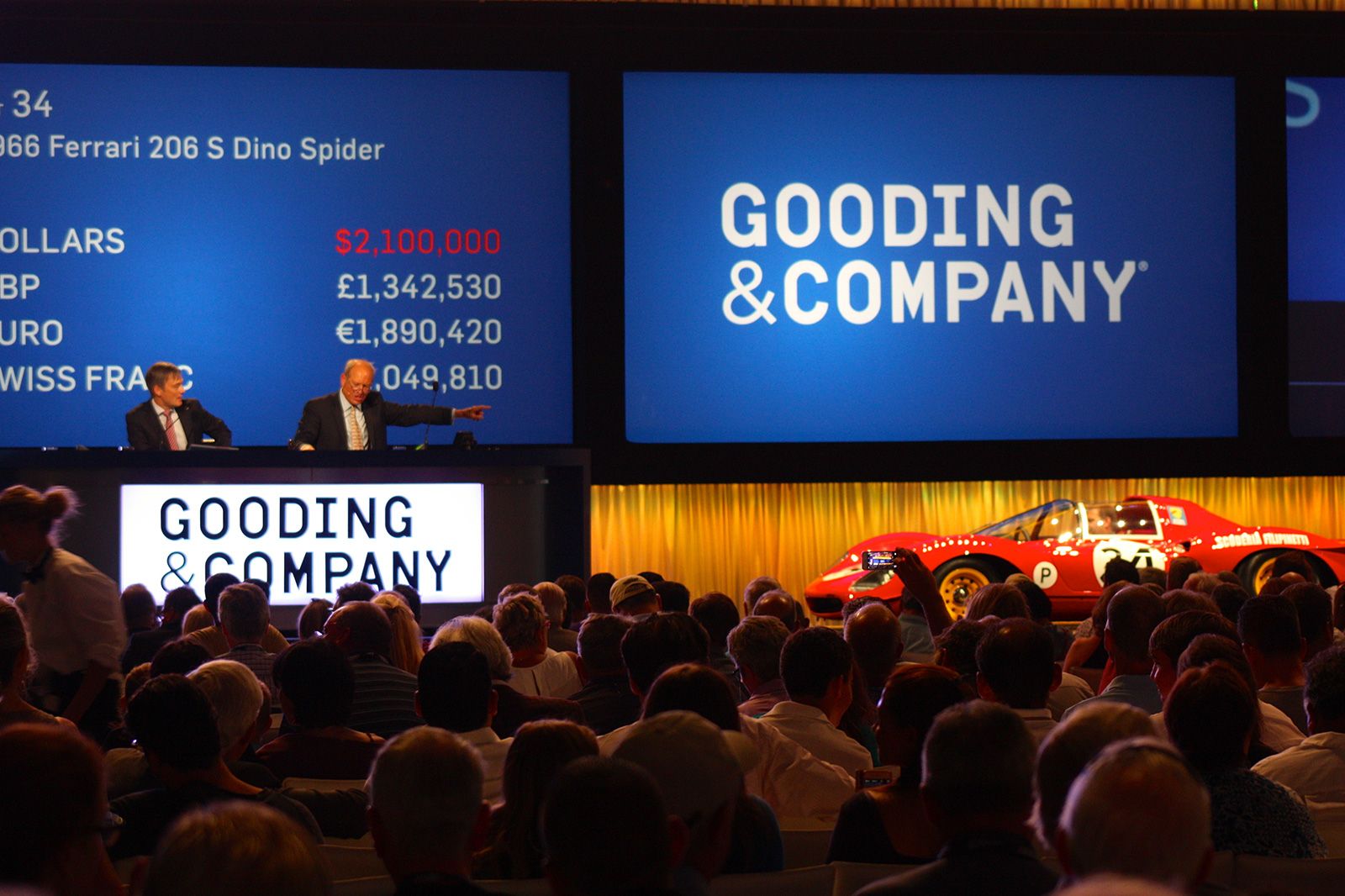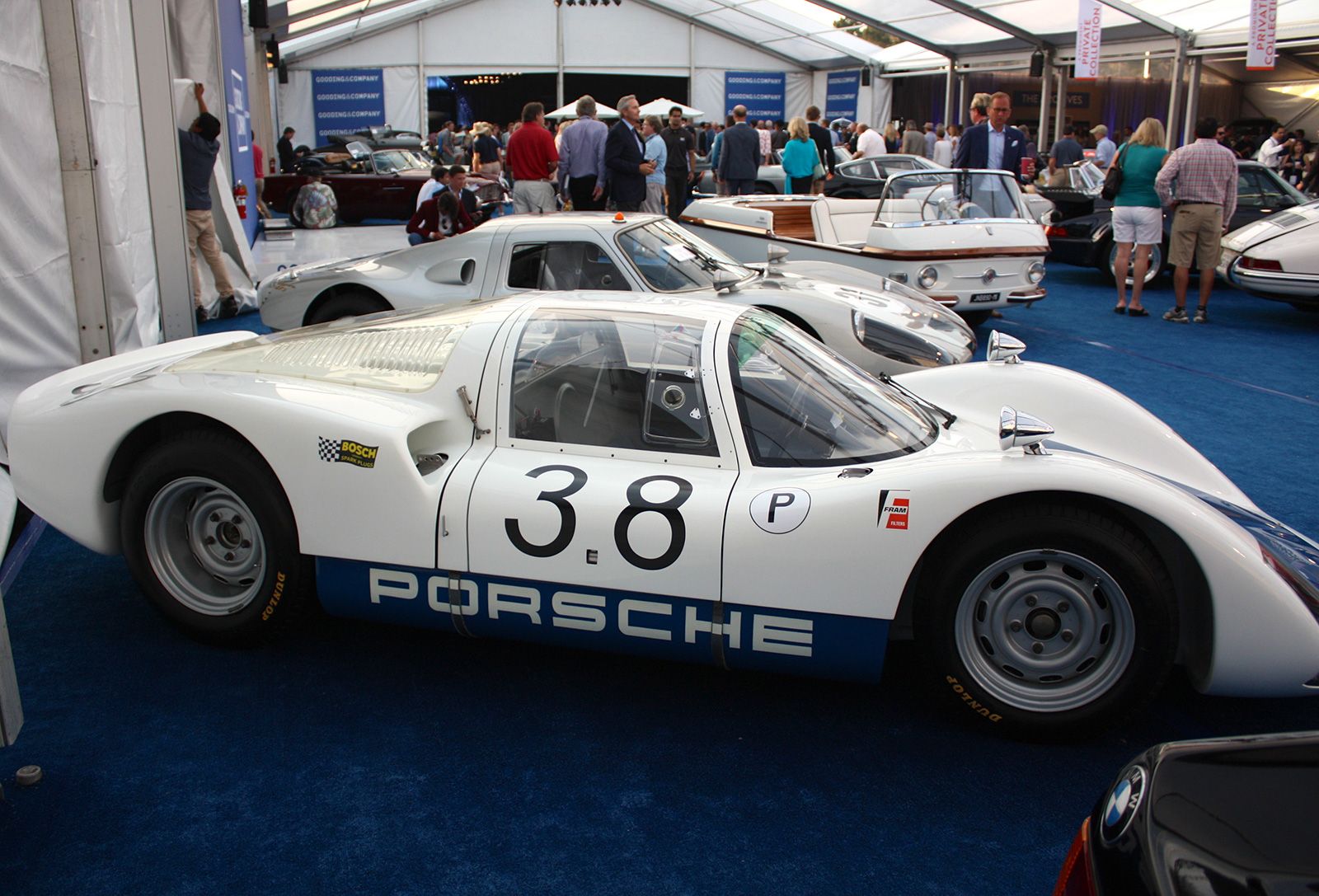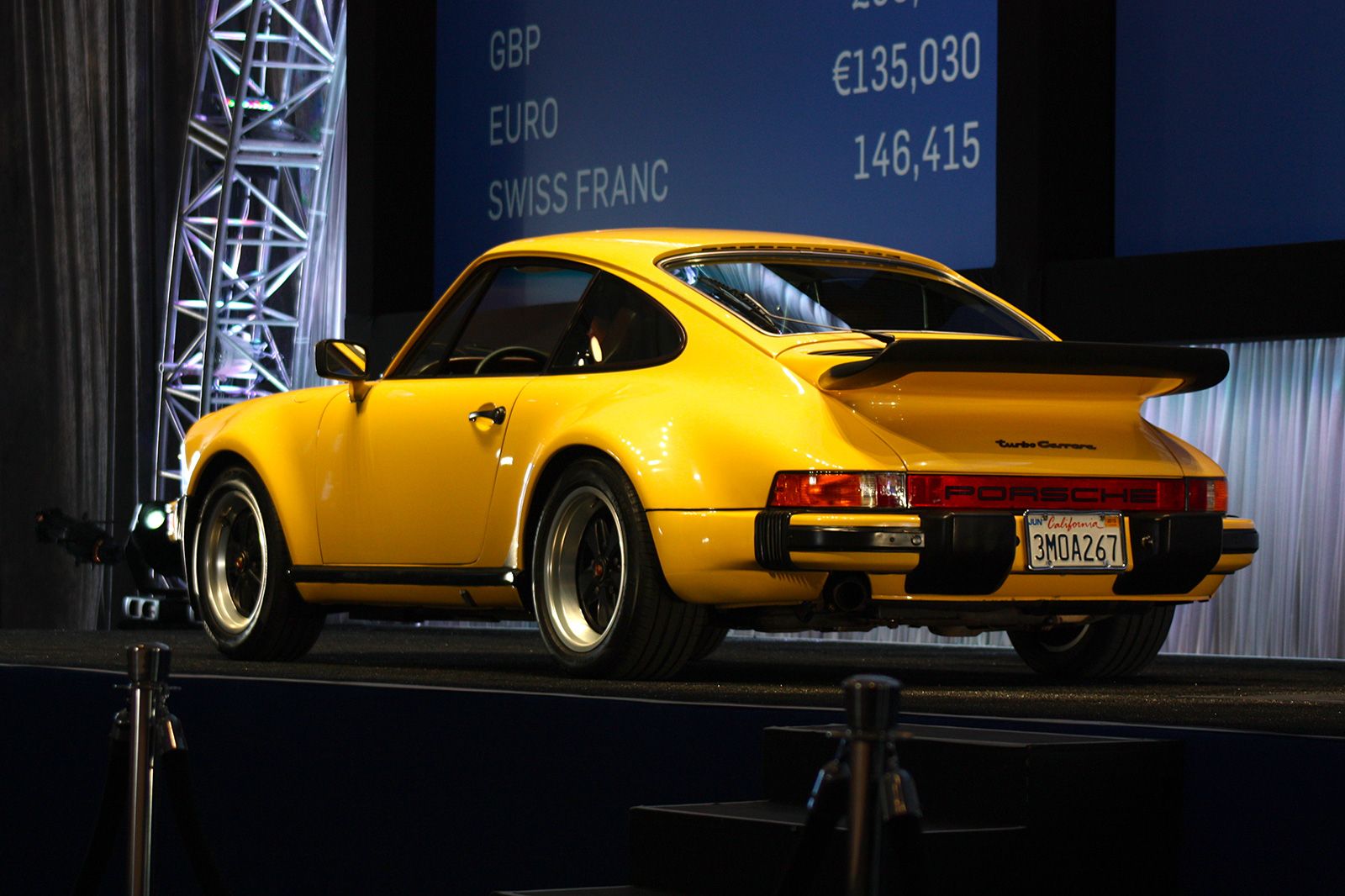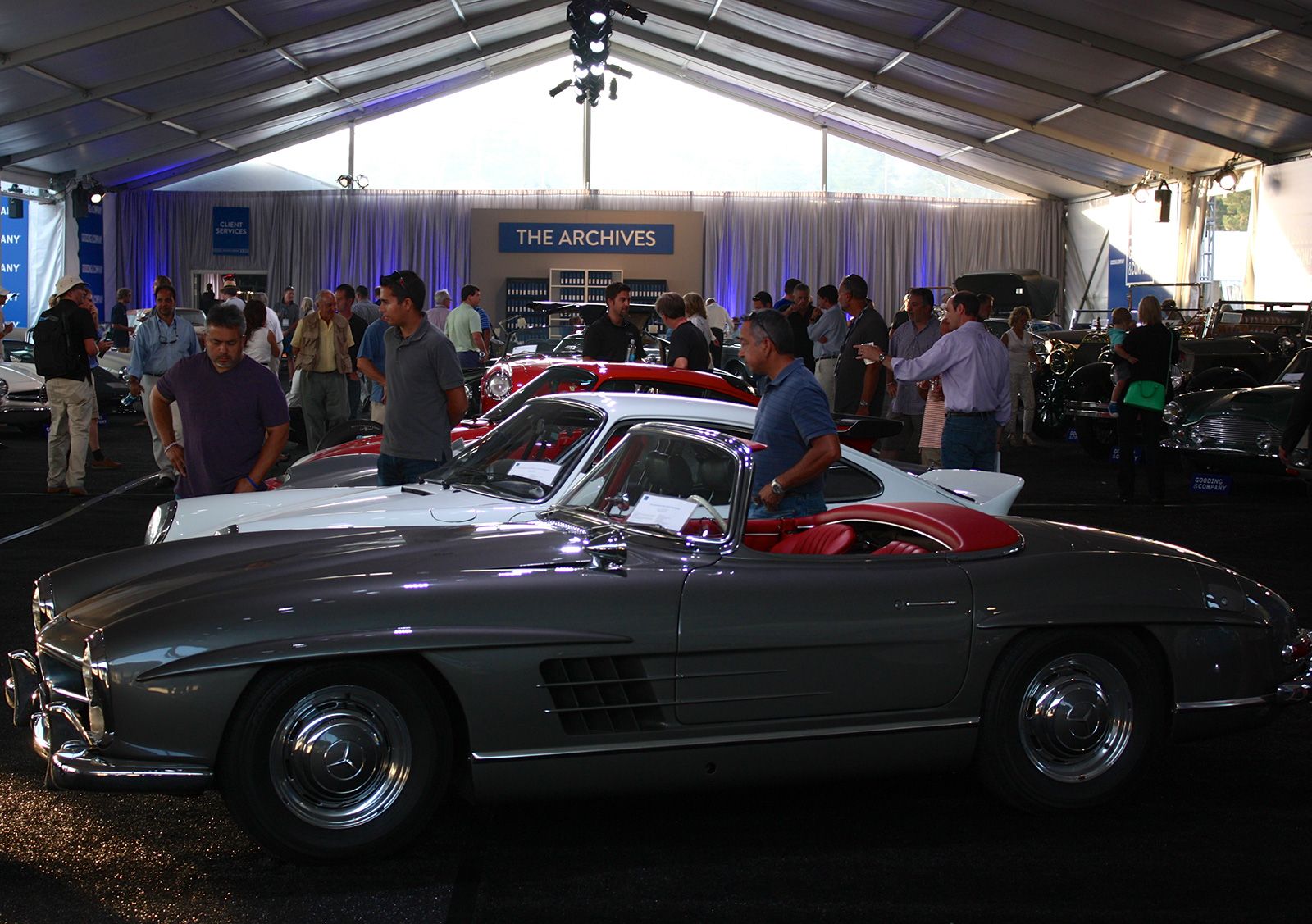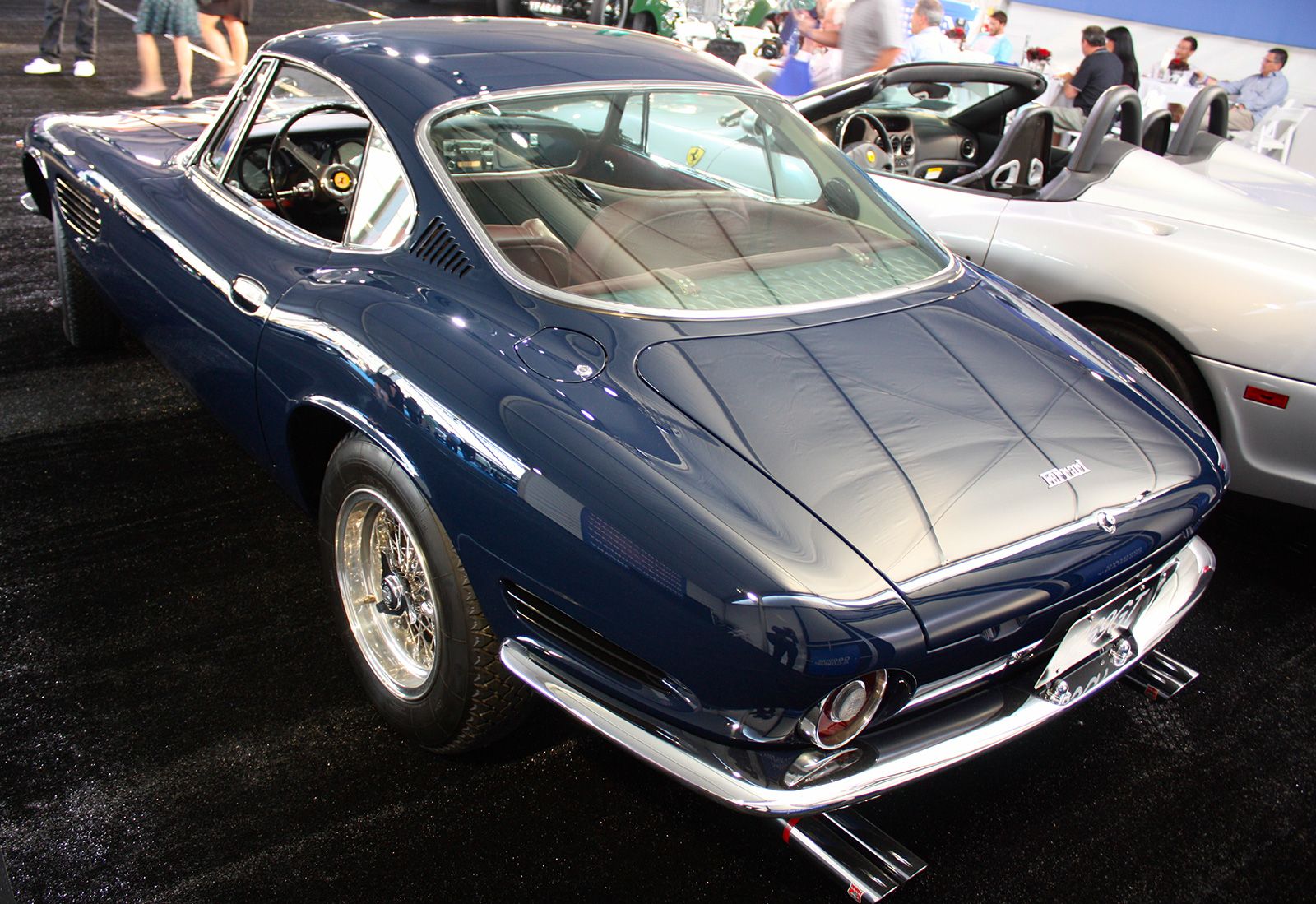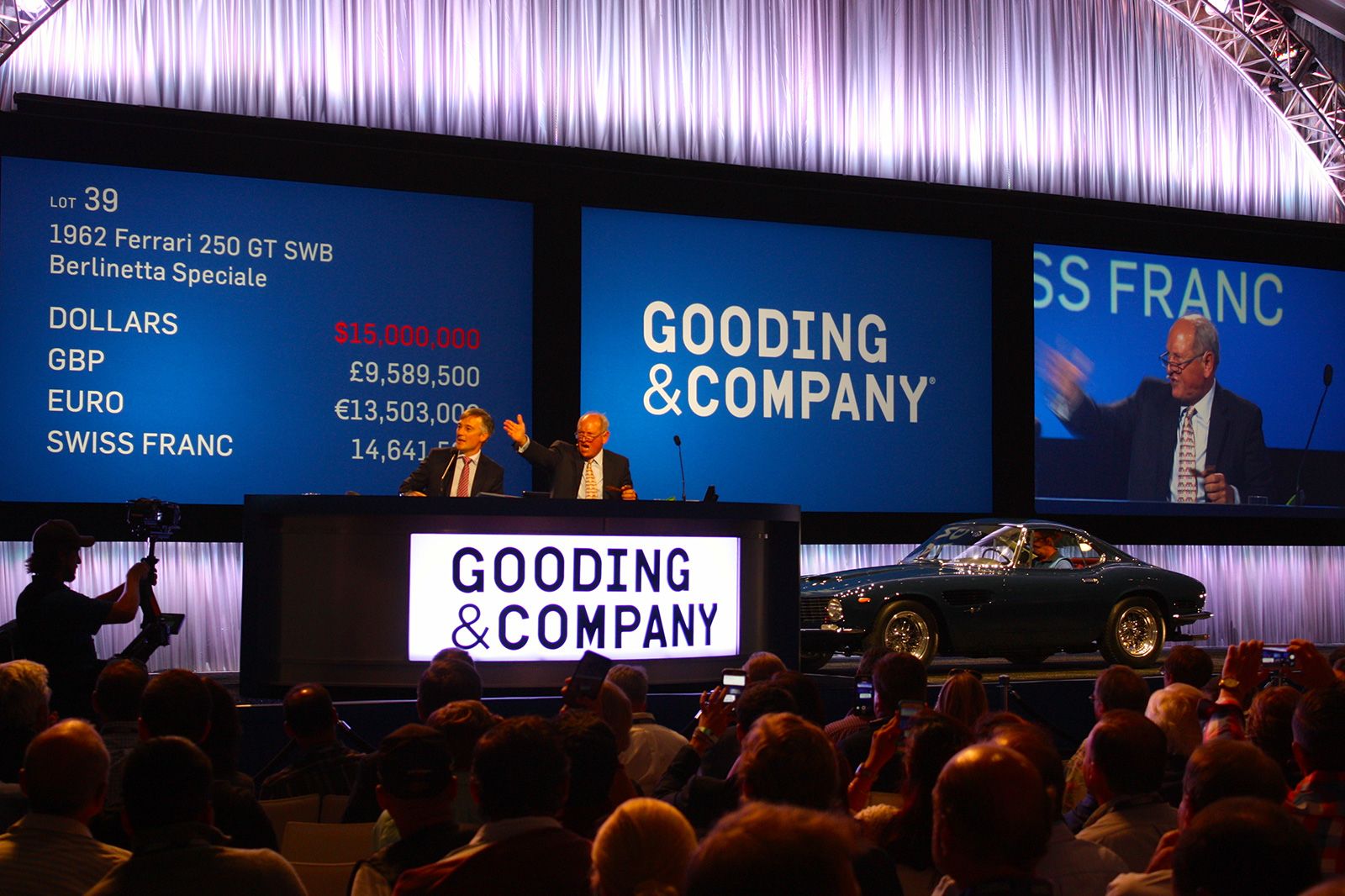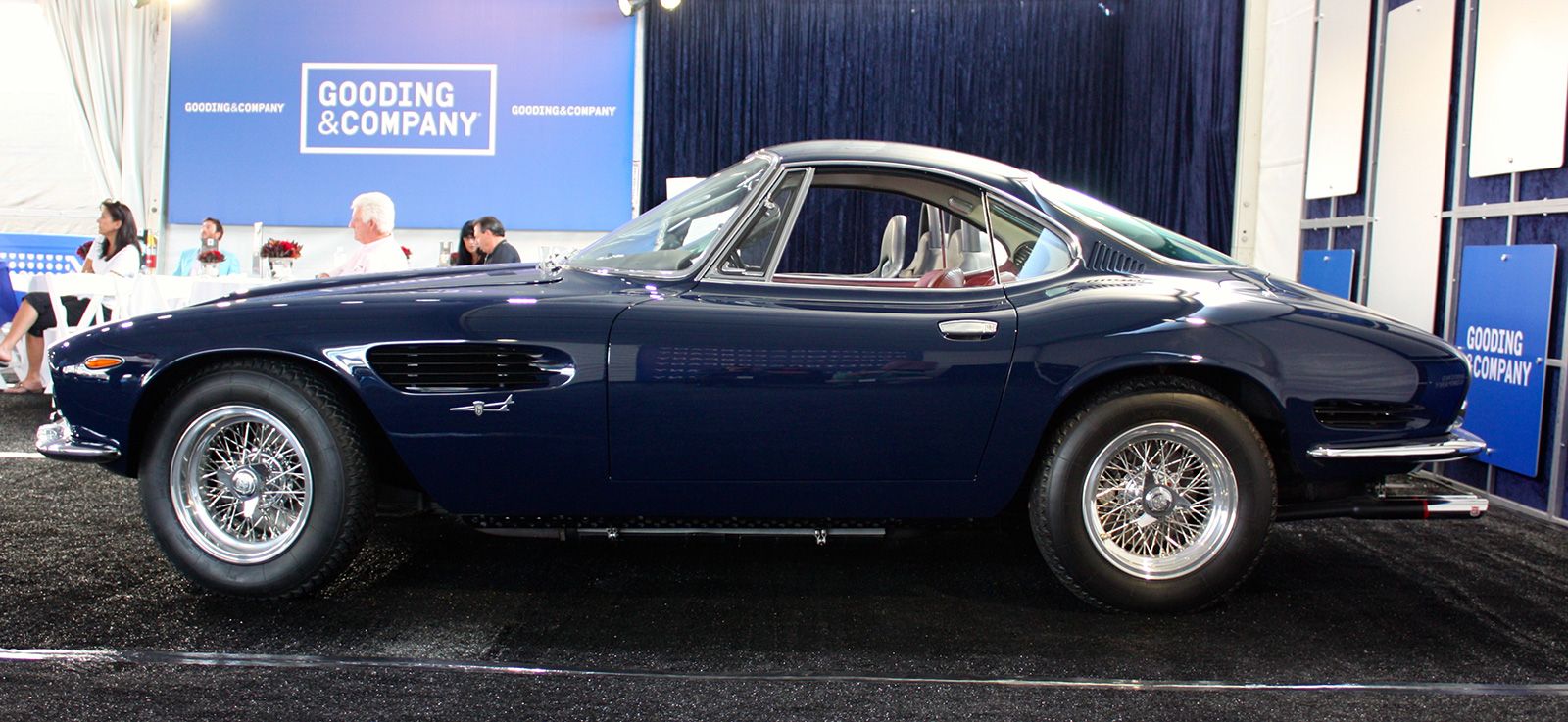What does it take to be considered elite? In the world of racing, the criteria are crystal clear – you gotta win. Consistently. Easy to say, but hard to do, especially with a small team against the experience of a marque like Ferrari->ke252. But between 1964 and 1965, Carroll Shelby did exactly that with the 1954 - 1965 Shelby Daytona Coupe, dominating during the season, taking victory at Le Mans, and securing the 1965 FIA Word Sportscar Championship, all at overseas racetracks like Spa, Monza and the Nurburgring->ke999. Along the way, names like Bob Bondurant, Pete Brock and Allen Grant contributed to the car’s success, further cementing their places among the racing elite.
In the world of automobile auctions, the criteria are less definite. Is it the quality of the vehicles? The prices realized? The rarity on offer? The prestige of the event? Probably all these things, and without question, the Gooding & Co. auction house has each in spades.
It was with these two groups that I experienced the penultimate day of Monterey Car Week.
Continue reading to learn what happened on Day 4.
Shelby Legends at Laguna Seca
As I drove inland along Highway 68, my head was still ringing with the sound of the Russo and Steele auctioneer rattling off prices from the night before. But there was no time for distractions like that – I was on my way to see the Shelby Legends speak at Laguna Seca->ke981, and I knew I’d have a horde of racing fans to contend with.
Coinciding with Car Week was the Monterey Motorsports Reunion, where classic race cars and sports cars were invited to tackle the Andretti Hairpin and the Corkscrew, adding to the ambiance of old-school awesome that prevailed throughout the central coast – a perfect fit for the Shelby Event. For our full review of the Monterey Motorsports Reunion, click here.
Laguna Seca is an amazing track. Built in 1957, its 11 turns and two and a quarter miles have hosted a variety of world-class events, from superbikes to sports cars. But it wasn’t the frenetic whine of 1,000 cc at 16,000 rpm or the unearthly wail of a modern turbo-diesel prototype that greeted me as I crossed the footbridge between turns 3 and 4. Rather, it was the rocket-ship-blast of mid-70s GT cars chugging race fuel like it was going out of style that propelled me.
The Shelby booth was easy to spot. Not only was it lined with modern Mustangs->ke428, each painted crimson red, massive blowers glinting in the sun, but parked out front was a 50th Anniversary Daytona Coupe in bare aluminum, its voluptuous body panels reflecting the late morning sun with a blinding metal aura. Next to it was a fiberglass counterpart in the traditional blue with white stripes. Standing tall alongside the Daytonas were Bob Bondurant, Allen Grant and Pete Brock.
You might recognize the name Bondurant from the popular driving school, but before he signed up to help others go fast, Bob Bondurant was driving the wheels off just about anything he could get his hands on. He started with motorcycles, eventually moving on to sports cars. Then in 1963, he joined up with Carroll Shelby as part of the Ford Cobra team, winning several races stateside and in Europe. In 1964, Bondurant paired with Dan Gurney to drive the Daytona Coupe at the 24 Hours of Le Mans, taking an epic underdog victory in the GT Class against longtime rival Ferrari.
Allen Grant was another Shelby driver, but unlike Bondurant, he got his start on the Shelby team as a mechanic and welder. Once the top brass learned he had a few years of college under his belt, Grant was moved up to the office to work behind a desk. It was a good promotion, but Grant had little interest in pushing pencils. Eventually, he was able to work out a deal driving a Cobra under a privateer designation, winning in Santa Barbara in his very first race. A string of successful efforts followed, and Grant was hired as a team driver, going on to wheel the Daytona Coupe in Europe.
Pete Brock was the driving force behind the Daytona’s design. After winning Le Mans in 1959, Carroll Shelby wanted to beat Enzo Ferrari in the iconic endurance event using a car of his own creation. Although Shelby’s AC Cobra was highly successful, its open top created a good deal of drag down the 3-mile long Mulsanne Straight, limiting its top speed, a critical weakness against the 186-mph 1962 - 1964 Ferrari 250 GTO. Shelby turned to Brock for a solution, and the result was the curvaceous Daytona Coupe. Despite misgivings from others on Shelby’s team, the Daytona proved its worth, topping out at over 190 mph.
After a few quick photos around the 50th Anniversary recreations, the three Shelby Legends sat down to discuss what it was like in the old days. Brock told how he designed the cockpit around the physique of test-driver Ken Miles, instructing him to sit in the cabin and hold the wheel in the most comfortable position to get the proper dimensions. This resulted in a bit of discomfort for the taller, larger Grant, who remembered climbing out of the Daytona with scuffs on his helmet caused by the low roofline.
Most memorable, however, was the feeling of winning overseas. With a look of complete satisfaction, Bondurant recalled how victory at Le Mans brought the American team a good deal of admiration from the Europeans. Taking down the competing marques was by no means an easy feat for the outgunned Shelby crew, and the respect they gained had a far greater impact than any trophy.
Grant went on to say that although Ferrari was without a doubt their biggest rival, teams like Porsche->ke1 and Aston Martin->ke13 were also quite strong, a fact often overshadowed by the competition between Shelby and Ferrari. Bondurant, however, maintained that the biggest competition came from his teammates.
While remembering the past, the Shelby Legends were also optimistic about the future. Each looked forward to seeing Ford’s return to Le Mans, complimenting the new GT’s stunning exterior design. Bondurant said it was a truly beautiful thing to look at, with gorgeous lines that appeared aerodynamic and agile. He added that in the ‘60s, Ford went to Europe with a new car and very little testing. This time around, they were much better prepared, a statement that produced a series of patriotic whoops from the enthusiastic crowd.
I started to head out as those in attendance lined up for an autograph session. But before I left, I spent a few moments at the start-finish line, watching Formula 1->ke190 cars from 40 years in the past crest the hill, contemplating the way it used to be as they took turn 1 at 115 mph.
Gooding & Co. Auction in Pebble Beach
Several hours later, after sweating my way through late afternoon traffic, I found myself strolling up the blue carpet of the Gooding & Co. Auction tent. Slick Easy Listening jazz, $13 turkey sandwiches, and many millions of dollars in premium automobiles were there to greet me.
The lots were arranged in a viewing area, all lined up in neat rows, ready to roll when the gavel began to fall. Individual estimated values didn’t fall below the six-figure mark. Many were worth several million. The vast majority hailed from Europe->ke139, and included antiques, classics, modern supercars, and race cars.
After attending the Russo and Steele auction the night before, I wasn’t quite prepared for just how different the Gooding & Co. event would be. The main tent was enormous. Rows of reserved bidder’s chairs faced a stage backlit by three enormous screens; one to display the current price (broken down into U.S. dollars, British pounds, Euros, and Swiss francs), one to display the real-time footage of a crane-operated camera panning over the car to be sold, and one with the Gooding logo.
The first lot to roll out was a 1963 Mercedes-Benz 230 SL. Estimated value: between $160,000 and $200,000, without reserve. Rather low compared to the evening’s average.
Camera in hand and press credentials on display, I strolled toward the stage with confidence, only to be instantly rebuked by a protein powder-loving member of security. The camera and credential were meaningless – I would have to stay behind a certain velvet rope, about 50 feet from the action.
Luckily, I brought my telephoto lens, and all the cars were available in the viewing area. I wanted close-up shots of the cars on stage, but it was not to be.
Slowly, the lots began to trickle through. The auctioneer took his time, pronouncing each sum with an exacting British accent, a stark change of pace from the chaotic sound flood at Russo and Steele. The restrained audience shrewdly evaluated each bid, looking for opportunities with calculating precision.
The smallest counter-bid price increments were in $5,000 sums, with the million-dollar lots seeing counter-bids of $250,000. At one point, while waiting for a counter-bid that would raise the price of a 1957 Porsche 356 Speedster from $275,000 to $300,000, the auctioneer goaded the hesitant buyer with “It’s only money, sir,” eliciting a hearty chuckle from the crowd. The Speedster ended up selling for $350,000.
Seeing all that beautiful metal on the stage, I was drawn forward like a moth to the flame. The lighting made the cars glow irresistibly. At one point, a 1966 Ferrari 206 S Dino Spider took the spotlight, glistening with hand-carved red brilliance. I desperately wanted to get closer, but as soon as I stepped out of the designated press corner, I was immediately reprimanded.
I remember thinking with frustration, “What’s wrong with these people? Don’t they want the coverage?”
But as the gavel fell for the Dino at $2.1 million, the answer dawned on me – they didn’t care. The Gooding & Co. Auction is not a car event like the Russo and Steele Auction – it’s an investment event in the guise of a car event. With all the sterility of a board meeting at an international banking firm, these transactions were taking place in order to see assets moved, not to fill the dreams of hardcore enthusiasts. At one time, these cars were machines, but now they were safe investments for multi-millionaires.
With that in mind, it all started to make sense. Don’t get too close, stand in one corner and report. Don’t take pictures of the audience – it would be as rude as looking over someone’s shoulder as they cashed a check. Gooding doesn’t need advertising, but you’re free to observe. After all, privacy is, and shall continue to be, a privilege of the elite.
I smirked when the auctioneer told the buyer of a $660,000 1973 Porsche 911 Carrera 2.7 RS Touring to “Enjoy that, sir.” While I’m sure the buyer will enjoy the ROI he gets when the car is resold in a decade, for now, I’m fairly certain the car will sit in stasis in a nitrogen-filled garage among several other idle acquisitions.
The big excitement of the evening was Lot #39 – a 1962 Ferrari 250 GT SWB Berlinetta, with design by Giugiaro inspired by Ferrari’s shark-nose race cars and draped in rich blue. It was Nuccio Bertone’s personal vehicle, served as centerpiece in the Lorenzo Zambrano Collection for 30 years, and had several Best In Show awards from international concours events. God, what a beautiful machine! Bidding began at $5 million.
Almost immediately, absentee bidders and members of the audience drove the price up by increments of a million dollars. In a heartbeat, the price stood at $10 million.
Tension filled the air as the back-and-forth settled down. The auctioneer knew this was the climax of the evening, and took his time to draw out the tension, bringing the counter-bid increments down to $250,000. Once again, the price began to rise, passing the $11-million mark, then $12 million. Finally, the bidding stagnated at $13 million, going to the absentee bidder on the phone. Silence filled the room, and it seemed as though everyone was holding their breath.
For a moment, the Ferrari threatened to sell for $13 million. The price was called once. Then twice. Suddenly, the auctioneer exploded with excitement as a counter bid was issued from the audience – $13.1 million. One hundred grand was too meager an increase for the lot, but the man on stage knew he had the buyer hooked, and wrestled it to $13.25 The number started to rise once again.
Then came $14 million. $14.25. $14.5. $14.75. There it hung for what felt like minutes before the absentee bidder brought it to a round $15 million.
A sizable sum, even for this crowd. A murmur spread through the audience. $15,000,000 blazed across the screen behind the auctioneer as he called the number once, each passing second expanding the vacuous feeling of the room. $15 million was called a second time.
The gavel was raised. Suddenly, someone nearby (probably a journalist) cried out “Hurry up! We gotta pee!” Nobody laughed. The auctioneer responded: “Stop talking, sir.”
The tension resettled for a second, then down came the gavel. $15 million, sold to the absentee bidder. Final price after associated fees was $16.5 million. Crazy as it sounds, looking at the car, I couldn't help but feel that the buyer had gotten a steal. I know...it's another dimension.
And with that, most of the crowd got up to leave. Although 30 lots remained, including a 1964 Aston Martin DB5 (did not meet reserve), 1982 Porsche 956 race car ($10.12 million), and a 2015 McLaren P1 ($1.925 million), they knew none would exceed the $15-million price of the 1962 Ferrari 250 Berlinetta. In total, the Gooding & Co. Auction pulled in over $128 million for the weekend.
After getting a few more shots in the viewing area, I went back to headquarters and nuked a frozen bean and cheese burrito for dinner.

